A variety of parasites can live in humans. It can be not only multicellular and protozoa, but also viruses, bacteria, fungi. They parasitize at the expense of the human body. Harmful microorganisms can live not only in the intestine, but also in the muscles, blood, etc. With parasites, you need to start the fight as soon as possible. Otherwise, complications cannot be avoided.
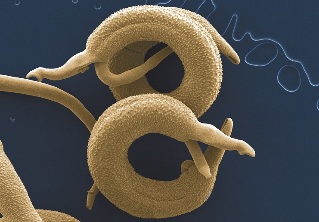
Varieties of parasites
There are many parasitic organisms that thrive in the human body. They all have specific characteristics.
nematodes
Nematodes or roundworms include about 1000 subspecies in their group. The most famous representatives are pinworms, Trichinella, toxocara, hookworm, nekator and nematodes. They enter the body through the mouth or skin. The main representatives of nematodes are described in the table.
| Parasite | Description |
| Pinworms | This is a round worm that does not exceed 2-12mm in length. Females are generally larger. These representatives parasitize in the lower intestine and large intestine. Adult females lay eggs in the perianal region. Most often, such representatives are found in children. Eggs fall on the patient's hands when scratching the anus, which itches in the presence of such parasites. Itching is one of the first symptoms. |
| Trichinella | The Trichinella is a nematode. Parasites enter the body along with poorly processed meat. After they have entered the body, its complete intoxication begins. In an advanced case, the parasites can be fatal to humans. |
| Toxocars | This parasite often lives in animals, including cattle. Young children are highly susceptible to toxocariosis. The parasite multiplies very quickly, so treatment should be started immediately. |
| Hookworms | It is believed that every 4 people on the planet are carriers of this parasite. An adult can live in the host's body for 8 years. With proper and timely treatment, 95% of 100 patients can be cured of hookworms. The parasite enters the body along with the contaminated soil. |
| Nekator | These reps are small. Their length reaches 2 cm. The female parasite lays up to 10 thousand eggs per day. The parasite larvae enter the external environment along with the feces. |
| Ascaris | Nematodes can grow up to 35 cm in length First the parasite develops in the small intestine and then spreads throughout the body. For individuals to become sexually mature, it is necessary to re-enter the body. |
After the nematodes enter the human body, the process of developing pathological symptoms begins. The intestinal walls become inflamed and, for this reason, the functioning of the digestive system is disrupted. Parasites in the body are a serious threat. They absorb some of the nutrients.
Tapeworms
Tapeworms or tapeworms present in the body cause tapeworms. Adults are found only in the intestines. The larvae are able to spread throughout the body. A person can be infected with the following tapeworms:
- Wide tape. This is the longest helminth in the world. It is capable of growing up to 15-17 meters. Wide tapeworm causes significant damage to the human body. Ulcers are formed at the site of its attachment.
- Bull tapeworm. This is another major parasite that negatively affects human health. It is found most often in the small intestine. Infection occurs when you eat contaminated meat that has been poorly thermally processed.
- Pork tapeworm. The tapeworm can grow up to several meters in length. Parasites can be carried by wild and domestic pigs.
- Echinococcus. Eggs enter the environment along with fecal matter. Infection often occurs when personal hygiene is not followed.
- Alveococcus. The parasite grows in length to 2, 2 mm. Infection occurs through food that is contaminated with contaminated feces.
The pathology occurs mainly with disorders of the gastrointestinal tract. A disturbance of nervous activity appears. A person's well-being constantly deteriorates.
Fluke Worms
Flukes are flat worms. These are some of the most dangerous representatives. Almost all flukes parasitize the owner's body. Only at a certain stage of development do they change ownership.
Switching hosts eliminates possible overpopulation in the host's body. The most common representatives of trematodes include:
- Siberian fluke. Infection occurs when eating fish that has undergone insufficient heat treatment. It is in the human fecal masses that the eggs of this parasite are contained. The parasite grows in length up to 13 mm. The body is almost completely transparent.
- Liver fluke. A parasite capable of infecting both animals and humans. An adult grows to a maximum of 8 cm. Infection is possible with the use of dirty plants, on which the fluke is already in its intermediate form. There is also a risk of water-based contamination.
- Shistosoma. If left untreated, schistosome can cause the patient to suddenly die. Only 6 varieties of this parasite are dangerous for humans. The microorganism can be located in the blood vessels, in the bladder. Infection often occurs when swimming in fresh water.
- Clonorhis. People who work in public catering are susceptible to infections. Clonorchis most often occurs in men over the age of 35. I'm at risk. The eggs of the parasite are excreted with the feces.
Most often, parasites enter the body when eating raw or undercooked fish. Another common option is the presence of poorly washed fruits and vegetables in the diet.
Trematodes
This is a type of flat worm. Their main feature is the presence of suction cups. Flukes include:
- Opisthorchiasis. The source of the infection is raw or undercooked fish. Symptoms are not specific, so it is difficult to diagnose the disease. The result is very often unfavorable.
- Fascioliasis. When infected, the liver and biliary system are damaged. A characteristic sign of human infection is a sharp increase in body temperature up to 39-40 degrees.
- Dicroceliosis. Helminthiasis, the causative agent of which is lanceolate trematode. In case of pathology, the liver and gallbladder are further damaged.
The parasite is widespread throughout the world and poses a serious threat to livestock and humans.
Protozoa
The simplest parasites are single-celled parasites. Some of the representatives are the oldest inhabitants of the Earth. Parasites successfully adapt to new conditions and reproduce thanks to their simple structure. The parasite can live both in the skin and directly in the human body.
The movement of unicellular organisms can be carried out with the help of cilia, flagella, pseudopodia. These types of parasites include:
- Flagellates. They have an oval or pear-shaped body. The main difference is the presence of flagella. Their number can be 1-8. The parasite sucks food all over the body. Infection can occur through insect bites, violation of personal hygiene rules and promiscuous sexual activity.
- Sporoviks. They are able to live in several human organs. Nutrition, respiration, the release of waste products are carried out from the entire surface of the body of the parasite.
- Infusorium. These are ciliary or sucking parasites. They live in fresh water, soil.
- Sarcode. The parasite is made up of a cell. Some sarcode species are able to live in human teeth if hygiene is inadequate.
Single-celled organisms can lead to a number of dangerous diseases, including malaria, amoebiasis, giardiasis, etc. Infection is possible by the method of home contact, fecal-oral, through contaminated products, as well as a transmissible method.
Protozoa - infections caused in humans by the activity of protozoan microorganisms. Animals are also susceptible to disease. The pathologies they cause also include fungal infections.
In most cases, protozoan organisms reach humans from animals. In addition, their entry is possible through water, soil and person to person.
Ectoparasites
Ectoparasites are parasites that live on the surface of the body and external organs. They can be a provocateur of skin diseases. In addition, ectoparasites carry various infections.
The group of ectoparasites includes:
- Lice. It is a blood-sucking parasite. The oral organ pierces the human skin with ease. If necessary, lice can resist fasting for several days. Head lice can be body and head lice. Head lice are a serious threat as they can carry infectious diseases.
- Bloch. These are temporary ectoparasites. Passed from person to animal and back. It offers a strong discomfort to the bite.
- Ixodid ticks. Unlike other ectoparasites, ticks are easy to get rid of. For this, vegetable oil or paraffin is used. The main thing is to take the extracted tick for examination. This will help ensure that you are not a carrier of the infection
Most often, ectoparasites infect animals, but human infection, for example, ticks or lice, is also possible. Parasites feed on blood. They have a high reproduction rate.
Helminths
Currently, experts identify 280 types of worms. All of them are able to live and develop in the human body. It is a mistake to believe that helminthiases only occur in people from disadvantaged families. Worms can also occur in wealthy people who closely monitor their hygiene.
Helminths can be infected in many ways. Parasites can be spread by animals, from person to person and by contact with contaminated soil. Most often, worms appear in children. This is due to non-compliance with preventive measures.
The first symptoms may not appear immediately. They can appear after 2-3 days or several weeks. It all directly depends on the type of parasites that have entered the body. Helminthiasis can be both acute and chronic.
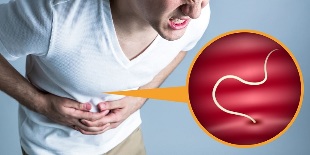
Classification of parasites
All parasites are divided into species. There are large groups of:
- method of infection;
- localization method;
- biological characteristics.
Each group has its own characteristics.
By localization type
Assign temporary, fixed and transit forms of location. In the first case, the parasite lives in the owner's body only at a certain stage of development. In a stationary form, parasites are constantly in the human body. The transient form is the period of migration of the parasite into its habitat.
During treatment, doctors always take into account not only the form of the parasite, but also the place of residence. In total, parasites are divided into 2 main categories. Parasites that live on the skin are referred to as ectoparasites. Parasites that have established themselves inside the owner are endoparasites.
Internal parasites, in turn, are divided into 2 categories: parasites of tissues and parasites of the abdominal organs. There are also atypical forms. In this case, the parasites are found in unusual places for them.
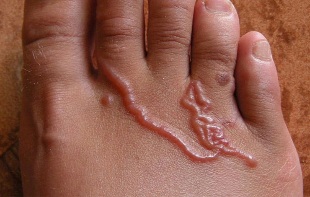
External parasites can be temporary or permanent. Those that feed on blood through bites are temporary. They can cause infections. The rest of the parasites violate the integrity of the skin.
There are also intracellular parasites. These include, for example, Plasmodium malaria.
By infection method
Parasites can also be classified according to the mode of infection. The following penetration methods are distinguished:
- Contact and family. In this case, parasites penetrate due to violations of sanitary and hygienic standards.
- Fecal-oral. In this case, the infection occurs through dirty hands and low-quality products.
- Transmission tracks. Infection occurs through blood-sucking insects.
- Active paths. This is the name of the method of infection, in which parasites get to the owner at the larval stage.
Thanks to the large number of ways to enter, you can catch parasites everywhere. Only preventive measures allow to reduce the risk of infection.
Based on biological characteristics
According to the biological characteristics, parasites are divided into two categories: unicellular and multicellular. The first group includes sporozoa, ciliates, flagellates, histological amoebas. The main method of infection ignores the rules of personal hygiene.
Worms, insects, arachnids are generally referred to as multicellular parasites. The danger of infection, for example, with helminths, is that worms damage internal tissues and organs.
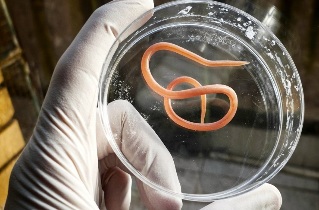
The most common multicellular parasites are worms.
Multicellular parasites are more dangerous. They are distinguished by their rapid reproduction rate and complex life cycle.
Where can parasites be found
Some parasites can live in specific parts of the body, while others can spread throughout the body. It is difficult to diagnose a parasite infection.
Nematodes live mainly in the digestive tract. Infection occurs when eating unwashed food.
Parasites can be found under human skin. These representatives include rishta. The parasite enters the body when it drinks raw water. Tourists who go on vacation to countries where rishta is common are often infected.
Internal organs infect flukes. They can live in the liver, pancreas, intestines, biliary tract. The main source of infection is the consumption of raw fish.
There are also tissue microorganisms. They can live in the spinal cord, muscles and connective tissues. The main source of infection are pets.

There are also eye parasites. They can be round, flat, ringed, prickly. The main source of infection is poor heat treatment of fish or contact with infected animals.
Danger of parasitic infections for humans
Any parasitic infection requires urgent treatment. The earlier the treatment is started, the faster it will be possible to cope with parasites and the fewer complications.
Parasites in the human body can lead to serious pathologies:
- Some parasites cause severe colitis. The condition is greatly aggravated if the patient has an ulcer. There may be blood in the stool, which is dangerous for the development of anemia. Treatment should be started as soon as possible.
- Parasites can reside in the brain or liver. This condition can be dangerous not only for the health, but also for the life of the patient. If infected, there is a risk of developing a cyst.
- Parasites living in the intestine can compromise its integrity. Furthermore, there is a risk of obstruction.
- Parasites deal a severe blow to the human immune system. Destruction of leukocytes and erythrocytes occurs. This almost instantly affects a person's overall well-being.
- Parasites take nutrients from the human body. The risk of developing thyroid disease increases anemia. In addition, the condition of the hairline and nails deteriorates.
- The body is poisoned by toxic components. The waste products of parasites are poisonous to humans. The more there are, the worse the person's well-being. The risk of developing allergies, asthma and asthma attacks is increased.
Parasites are particularly dangerous for children. The infection turns into a large number of unpleasant symptoms. The child loses his appetite, body weight decreases, apathy and fatigue appear. Your baby may cry often and become restless. Visible dark circles appear under the eyes.
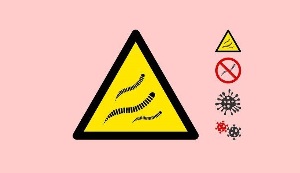
The baby is in the growing phase, so it is important that he gets enough nutrients. With parasites in the body, this is not possible. The condition of the child is rapidly deteriorating every day. The child can experience severe developmental delay.
The danger of parasites is that they can live in a person for months and years without making themselves felt in any way. During this time, it will weaken significantly, coping with a lack of nutrients. Possible complete exhaustion. Only timely treatment can help prevent it.
Factors contributing to infection
Often people themselves are responsible for the appearance of worms. There are a number of factors that increase the likelihood of parasites. These include:
- refusal to wash hands before eating;
- infection from dirty shoes;
- ignoring the signs of worms in pets;
- drink raw water;
- eating unwashed fruits and vegetables;
- poor heat treatment of meat and fish;
- often eat out;
- weakening of the immune system after taking strong drugs.
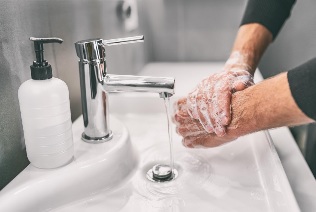
The eggs of the parasites enter the intestine first. Subsequently, they are absorbed into the bloodstream and the larvae are transported throughout the body.
Parasites spread more rapidly in large groups of children. This is due to ignorance of the rules of hygiene and too close contacts.
Symptoms of the appearance of parasites in the human body
It is important to know that sometimes parasites do not manifest themselves at all for a long period of time. Symptoms are often general and are almost invisible at first.
The first symptoms of parasites in the body are a rapid and unreasonable loss of body weight, as well as the appearance of an itchy sensation in the anus. It is possible to check for parasitic infections only through diagnosis. Symptoms of the infection often include various nervous system disorders and general body weakness.
A person who has parasites suffers from vitamin deficiency. This contributes to the appearance of fatigue, severe drowsiness and constant apathy.
If parasites live in the intestines, problems with the digestive system are inevitable. Diarrhea can alternate with constipation. There is a risk of increased gas formation and pain in the right hypochondrium.

In the presence of parasites, the protective functions of a person are reduced. Due to poor immunity, there is a risk of various infectious diseases.
One of the most obvious signs of parasites is the spontaneous appearance of allergy symptoms. Also, allergic rhinitis or persistent dry cough can begin to bother.
Diagnosis of helminthiasis
Only after diagnosis and confirmation of the presence of worms can they be treated. To make sure that parasites are present, doctors use several diagnostic methods:
- Macroscopic. For him, the patient's feces are taken for analysis. A microscope or magnifying glass is used as additional equipment. This method is used to look for pinworms or roundworms.
- Microscopic. For this, a thick stain is taken, which is further examined on a special membrane.
- Immunological. In this case, antibodies to a particular type of helminth are searched in the blood. This method is used to search for a huge number of different parasites.
- Biopsy. The presence of worms is determined by examining the muscle tissue.
- Instrumental. Such methods are used to determine how much internal organs and tissues are damaged by parasites. These methods include ultrasound, X-rays, computed tomography.
Treatment of parasite infestation
To get rid of parasites, you can give preference to both pharmacological methods and folk methods. It is better to combine them. In this case, the effectiveness of therapy will be more pronounced and rapid.
The treatment is selected on an individual basis. The most effective therapy is selected by the doctor, taking into account all the characteristics present in a particular patient.
Folk remedies for parasites in the human body
Traditional methods of treatment are no less effective than drugs. Their main advantage is total safety for the patient.
One of the best medicines is garlic juice. Contains phytoncides. It is they who destroy parasites in the body. The juice is taken three times a day. Start with 5 drops a day. The dosage is gradually increased.
Another effective remedy is wormwood tincture. Like garlic, it contains phytoncides. To prepare the medicine, 1 tablespoon of wormwood is mixed with 100 ml of alcohol. The drug is insisted for a week in a dark place. Take 20 drops 3 times a day. The tincture is used 20 minutes before meals.
It is good to include a lot of carrots in your diet and drink their juice. It has a detrimental effect on parasites. It is recommended to take 1 glass of fresh carrot juice 30 minutes before meals.
Herbal decoctions have a great effect on the body. To prepare a remedy for parasites, mix 1 tablespoon each. tansy, wormwood, poplar bark. All components are poured into a glass of water and brought to a boil. Take after cooling. Drink the broth 3 times a day, 125 ml before meals.
The main disadvantage of traditional therapy is that some drugs can provoke an allergic reaction if there is an intolerance to specific components. In this case, you will have to review your therapy and find a decoction or tincture that does not include allergens in its composition.

It is also believed that to combat a small number of parasites it is enough to reconsider one's diet. In the menu you need to include:
- pumpkin seeds;
- raw fruits and vegetables;
- coconut and pineapple;
- chile;
- garlic;
- various vegetable oils.
All these products have a negative effect on the activity of parasites.
Medicines for parasites
The drug is more effective. The main thing is to deliberately take all drugs. It is important to know that they are powerful, so their use is possible only after consultation with a doctor.
Self-medication with worms drugs is strictly prohibited. There is a risk that the patient will worsen their well-being by using the wrong medications required in a particular case.
Prevention of parasites in the human body
It is easier to prevent the emergence of parasitic microorganisms than to fight them in the future. Everyone must comply with existing security measures. For this we recommend:
- only uses purified water for washing food and drinking;
- not to use other people's personal hygiene items;
- administering anti-parasite drugs to animals for prophylaxis;
- stop eating dirty fruits and vegetables;
- stop eating raw fish.
Diagnostics are periodically required to ensure that no harmful microorganisms are present. If preventative measures are taken, the risk of infection is minimal. It is especially important to make sure that children follow the recommendations. It is they who are in the main risk group.




























